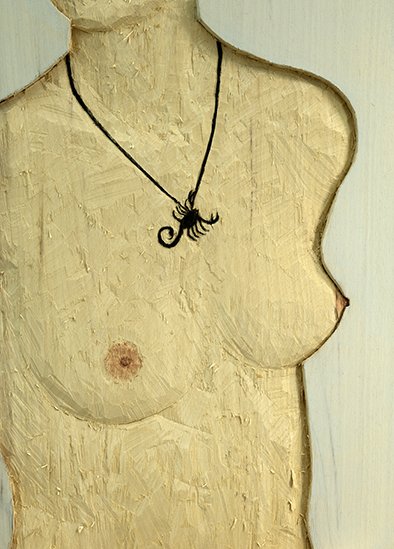Balkenhol’s figures are rendered in simple, confident shapes: a human being with the head of a hedgehog, a shark with a man hidden inside it, or a monumental statue of the Greek hero Perseus with Medusa’s head. In HALL 3, Kunsthal Rotterdam is showing a varied selection of his wooden sculptures and reliefs. Balkenhol’s visual language is rooted in European art history, interspersed with influences from Ancient Egypt, the Middle Ages, and the Renaissance. At the same time they have an everyday quality that invites us to come up with our own interpretations.
Counter movement
In the 1980s, Balkenhol decided to exclusively make figurative work, a counter movement to the dominating abstract, minimalist, and conceptual art movements of that era. This choice marked the beginning of his success and set him apart from his contemporaries. Famous examples of Balkenhol’s work are his sculptures of men dressed in dark trousers and light shirts in unremarkable, tranquil poses, thereby relating a universal human narrative. In his Zodiac series, Balkenhol plays with the ancient symbolism of the zodiac. He translated its twelve signs into contemporary forms. At the Kunsthal, these reliefs will all be shown together for the very first time. Also on display is the work Mickey Mouse (2022): a striking relief depicting a man’s head with Mickey Mouse ears, incorporating Balkenhol’s early fascination with pop art. The sculpture’s apparent joyfulness sharply contrasts with the melancholic look on the man’s face.
Craftmanship
Throughout the years, Balkenhol has been developing a unique style characterised by simplicity and craftsmanship. He makes all his work by hand, without the help of computer-controlled machines. Starting with a chainsaw for the more heavy-duty work, he subsequently picks up his hammer, chisel, and gouge to fine-tune even the tiniest detail of each of his sculptures. A characteristic feature of his work is that the traces of the cutting process remain visible. Both Balkenhol’s figures and their plinths are cut from a single block of wood, often derived from poplar, wawa, or cedar trees. According to Balkenhol, wood is just the right material to accompany his pace of thinking and working; while stone is ‘too slow’ and plaster and clay are ‘too fast’, wood is both obstinate and lively and allows him the space to make discoveries while chopping.
About Stephan Balkenhol
Stephan Balkenhol (Fritzlar, Germany, 1957) studied at the Hochschule für Bildende Künste in Hamburg between 1976 and 1982. Here he was taught by the likes of Ulrich Rückriem, Nam June Paik, and Sigmar Polke. Balkenhol lives and works in Kassel, Karlsruhe, and Berlin in Germany, as well as in Meisenthal in France. He was a professor at the Staatliche Akademie der Bildenden Künste Karlsruhe. Balkenhol’s work is exhibited around the world and part of numerous art collections, including those of Hirshhorn Museum Washington, Centre Pompidou Paris, and Peggy Guggenheim Collection Venice. Around the world, his work is displayed in many prestigious museums and in the public space, where his monumental sculptures make meaningful statements, for instance the Richard Wagner Denkmal (2013) in Leipzig. On Friday 4 April 2025, a new work commissioned by Rotterdam concert venue de Doelen was unveiled: a statue of the Dutch composer Willem Pijper (1894–1947).
for the press






